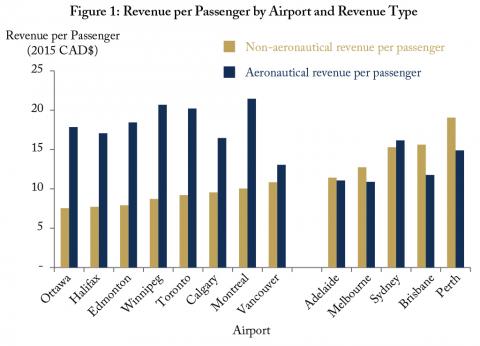From: Benjamin Dachis and Vincent Thivierge
To: The Hon. Marc Garneau, Minister of Transport
Date: March 24, 2017
Re: Following the Australian Airport Model Can Cut Fees for Travellers
There’s been much talk about whether the government should sell some of its ownership stake in Canada’s major airports. The fiscal benefits of more money to invest in infrastructure like schools and hospitals are clear. What will the benefit be for travellers? You should look at how for-profit Australian airports have better served travellers than Canada’s not-for-profit Airport Authorities.
Looking at the most recent financial statements from the largest Canadian and Australian airports shows that they collect about the same amount of total revenue per passenger: about $28 per passenger (all figures in 2015 Canadian dollars). But the major Canadian and Australian airports collect their revenues in different ways.
Canadian airports collect most of their revenues in ways that travellers can’t avoid, called aeronautical fees: ticket fees and charges that airlines pass onto consumers. The average Canadian airport charged $18 per passenger in aeronautical fees, compared to less than $10 per passenger in non-aeronautical revenues, such as retail or land rentals (See figure 1).
Australian airports, however, collected more than half of their revenues from non-aeronautical fees. Airports in Australia had mandatory fees for travellers that were one-third lower than those at Canadian airports ($13 per passenger). These for-profit airports made up that revenue using more ingenuity to find other ways of getting consumers who wanted to buy more at the airport to do so, not through ticket fees that travellers couldn’t avoid.
The total average cost to travellers was the same, but Australian travellers had a choice of whether to pay more or not. Here in Canada, everyone pays a high cost to use our airports.
Adopting the Australian airport model will help consumers. Why? First, the federal rent structure that Ottawa charges airports creates a strong disincentive for airports to seek new revenues. Second, for-profit airports are more efficient and passenger-friendly. Evidence from Europe – where about 75 percent of travellers now go though airports with a private ownership stake – shows that airport charges fell when governments opened up ownership of their airports.
Canada can follow models around the world in which governments put in place broader ownership of airports, with the government often holding a majority stake along with some form of airport regulation.
The benefits of more money for new infrastructure and lower fees for travellers means that you should clear a partial sale of airports for takeoff.
Vincent Thivierge is a Researcher and Ben Dachis an Associate Director of Research at the C.D. Howe Institute.
To send a comment or leave feedback, email us at blog@cdhowe.org.






